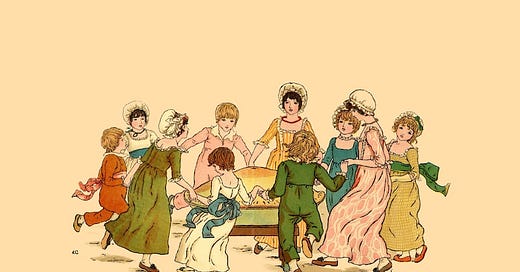Is nostalgia killing childhood?
Childlore is one of the great cultural inheritances of humanity, and one of the most enduring. But it's a fragile ecosystem, and whether it can survive the algorithm is an open question.
A MONTH OR SO AGO, my third-grader daughter came up to me after school and asked for a pad of paper and a pen. “What for?” I asked. I want to show you something cool, she replied.
So I fetched the supplies and handed them to her. She took the pen, bent over the pad, and started sketching, starting with three short parallel vertical lines, then three more right below them. Within a few seconds she had drawn this:
She looked up and gave me a sly smile, like she was letting me in on a big secret. “Cool, huh?”
I could only nod, because I was on the verge of tears, triggered by some weird emotional concoction of pride, nostalgia, and regret. She had drawn what a friend of mine used to call “the Metal S”, but which goes by a bunch of other names including the Cool S, the Super S, and the Surfer S. There was a stretch back when I was in grade six or seven where half the kids would spend the better part of a class ignoring the teacher and just sketching endless variations of the Cool S on their workbooks, their backpacks, their sneakers, and their jeans.
The Cool S is just one element of what has turned into a constant stream of memes my daughter has been bringing home from school this fall. There was a short-lived cat’s cradle craze in September; a few weeks ago she and I were walking our dog through the schoolyard on a weekend and she proudly showed off the hanging backflip off the monkey bars she had learned from a new kid in her class; a trip to the park the other day took twice as long as normal because my daughter and her friend were laser focused on avoiding the cracks in the sidewalk.
Neither her mother nor I taught her any of this, no adult did. These are all part of what is known as childlore, the furious mix of games, songs, rhymes, tricks, pranks, riddles, superstitions, rituals, and everything else that makes up the common and exclusive language of children. What is characteristic about childlore, unlike regular folklore, is that it is neither taught to kids by adults nor is it mediated by them. Instead, it is passed on between children, from older to younger siblings, from the upper grades to the lower, from kids in one school to friends and relatives in another. But this whole organic process is so self-contained that adults are often completely clueless as to what is going on under their very noses.
Which is weird, because any grownup can recognize childlore when they see it – after all, they were once children too. Childlore is everywhere if you know how to look for it: it is the schoolyard house rules governing hopscotch or jump rope; the accepted mechanisms for selecting who is “it” in tag – eenie meenie miney mo, or put in your patats and chant my mother and your mother were hanging out the clothes. Boys throw a baseball bat in the air and take turns gripping it higher toward the end to see who bats first; they show one another how to spell naughty words on calculators turned upside down; they spend hours drawing cool S’s on their jeans. And so on and on and on.
For the individual child, their immersion in childlore tends to end quickly and rather abruptly. By the time they reach middle school and enter puberty, they abandon the secret language of children and move into the more publicly semaphored world of adolescence. But still, somehow, this whole culture manages to exist and perpetuate itself, down through the generations, with virtually no input or oversight from grownups.
Yet the fact of childlore, the existence of this hermetic culture of children, is hardly a secret. Exploring its recesses is a staple of children’s literature, from Narnia to Roald Dahl to Charlie Brown. But it turns out that one of the most incredible characteristics of childlore is how conservative it is. In their groundbreaking 1959 book The Lore and Language of Schoolchildren, one of Iona and Peter Opie’s big ambitions was to explore the claim that the growth of mass media would have a corrosive effect on these childhood traditions. The worry was that mass media would undermine the self-contained nature of childhood and interfere with the child-to-child transmission of its folkways.
As the Opies’ research revealed, there was not much to worry about. Eenie meenie is from the early 1800s and hopscotch is at least a hundred years older than that. Kids have been taunting one another with “I know you are but what am I?” since the fifties. The Cool S that my daughter drew has been around since the 1970s. Some parts of childore, schoolyard songs and rhymes in particular, go back to the middle ages (the widely held idea that ring around the rosie was a plague chant might be false, though it does seem to have pagan origins). As the Opies showed, childlore is highly stable and resilient, even in the face of increasingly ubiquitous technologies of mass communication.
There are other looming threats, though. One is the increasing reluctance of young adults to leave their pre-pubescent culture behind. Whether it’s colouring books for adults, someone making the case for sleeping with stuffed animals into your twenties, the arch way thirtysomethings talk about “adulting”, or the creepola phenomenon of “Disney adults”... as the writer James Greig lamented about his peers recently, “we’re a generation of adult babies”.
This goes beyond run of the mill nostalgia. Sure, large and growing swathes of the culture are now explicit nostalgia plays, where middle aged post-hipsters are spoon fed the music and memes of their teens and twenties. I’m as guilty of indulging that as anyone (hence this newsletter). But at least built into the ideal of nostalgia is the presumption of aging, the acceptance of adulthood, the acknowledgment that life has stages, a beginning and middle and an end. The growing refusal by young adults to even leave childhood behind is a whole different gambit.
Them, when you combine this culture of perpetual infantilism with the rise of the absolutely vile kidfluencer phenomenon, you get something incredibly pernicious: the algorithmic marketing, branding, and commodification of childhood itself.
Whether childlore as a culture that persists and reproduces itself outside the purview and mediation of adults can survive this is an open question. I suspect it will, in some form anyway, though I’m not sure how much I would bet much on it. Like any fragile ecosystem, we might need to treat childlore as endangered or at risk, and a lot depends on adults knowing how to leave well enough alone.
One of the most difficult things to do, when my daughter is showing me the latest trick she’s picked up, is to keep myself from bursting the bubble and let on that I already know all about it.
I’m not always successful. Just the other day we were walking along and I noticed she was doing something complicated with her hands. I asked her what she was up to, and she showed me the old here’s the church, here’s the steeple thing. I decided to indulge myself a bit, and showed her a variation where at the end you don’t “see all the people” and waggle your fingers; instead you “kill” them – you open your hands and let your fingers lie flat like the end of a hand-puppet Tarantino movie. She loved it, and I suspect she has since shown it to her friends.
I wish I had resisted the urge to show off. There was no reason for it other than misplaced pride. I’m trying to take comfort in the quote from the folklorist Douglas Newton, which has become the unofficial motto of childlore researchers: “The world-wide fraternity of children is the greatest of savage tribes, and the the only one which shows no signs of dying out”.
I hope so.
I am extremely sorry for the extended break I took with this newsletter. It was not intended by any means; I took on a new job in September that took up more of my attention than I expected, and the weeks stretched into months and it got harder to get my writer’s brain back online. That job is finishing up and I expect to be back to regular programming now. There’s so much to talk about. ap
From the X-Files
Gen X is being blamed (or credited!) for getting Donald Trump elected. This won’t come as a surprise to readers of this newsletter.
Keanu Reeves turned sixty a few months back. He has a weird new novel with China Mieville that is getting… reviews.
This made me laugh.







I was very happy to see this article pop up in my e-mail this morning! I have missed your writings. I understand your reasons for the wait, though. :-)
It seems a key component of childlore's success/ongoing spread is personal connection. Childlore can't spread if kids don't hang out together. I'm less worried that parents or perpetually childish adults somehow ruin childlore than I am about screens and isolated (while connected virtually) play. When I walk on to my kids' school ground and see some of the older ones sitting against the outside school walls on their laptops, or peering over one another's shoulders at a phone – that's when I think it's time to worry if the well-worn rules of childhood and its governing ideas, rhymes, and inherent sense of fairness are being lost. Childhood, in this sense, doesn't die in adulthood, but in the space between the kids and the screen.